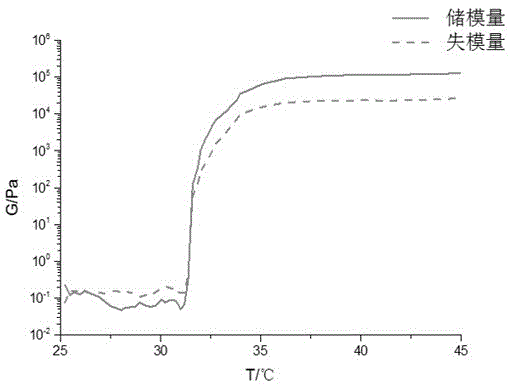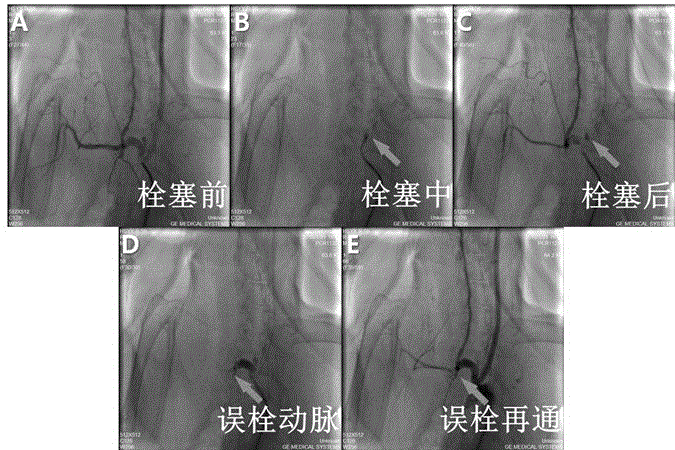Thermo-sensitive type interpenetrating polymer network hydrogel material and preparation method and application thereof
A technology of interpenetrating network and hydrogel, which is applied in the field of temperature-sensitive interpenetrating network hydrogel material and its preparation and application, can solve the problems of side effects, secondary damage, easy recanalization, etc. High load capacity and high biocompatibility
- Summary
- Abstract
- Description
- Claims
- Application Information
AI Technical Summary
Problems solved by technology
Method used
Image
Examples
Embodiment 1
[0039] Prepare graphene oxide aqueous solution by following formula:
[0040] ①At room temperature, while stirring in 70mL of concentrated sulfuric acid, add 3g of graphite powder spoon by spoon;
[0041] ② Transfer the mixture to an ice bath, add 1.5 g of sodium nitrate spoon by spoon, and stir for 15 minutes;
[0042] ③ Continue to slowly add 9g of potassium permanganate in the ice bath, stir for 15min, then transfer to an oil bath at 36°C, and react for 1h;
[0043] ④ Slowly add 150mL water by dropper and stir for 15min;
[0044] ⑤ After stirring, heat up to 90°C, react until the solution turns yellow, transfer to a 2000mL large beaker, add 500mL water and stir for 30min;
[0045] ⑥Add 20mL of 30% hydrogen peroxide, let stand overnight, and settle naturally;
[0046] ⑦ Pour off the supernatant, pickle twice with dilute hydrochloric acid solution with a mass fraction of 5%;
[0047] ⑧Wash twice with distilled water;
[0048] ⑨ Centrifuge the solution and dialyze to remo...
Embodiment 2
[0051] A clinically available graphene oxide-enhanced thermosensitive interpenetrating network hydrogel was prepared by the following formulation:
[0052] ① Take 5 mL of graphene oxide aqueous solution with a concentration of 7 mg / mL, and prepare 50 mL of graphene oxide aqueous solution with a concentration of 0.7 mg / mL;
[0053] ②In the above graphene oxide aqueous solution, add 1g of polyoxyethylene polyoxypropylene ether block polymer F-127, 5g of N-isopropylacrylamide monomer, 100μL of N,N'-methylene oxide with a concentration of 5mg / mL Base bisacrylamide aqueous solution, N 2 Stir at room temperature under protection for half an hour;
[0054] ③In the above mixed solution, add 0.5g ammonium persulfate, N 2 Under protection, stir overnight at 70°C;
[0055] ④ Cool the above mixture to room temperature, transfer to a centrifuge tube, centrifuge at 40°C, and immediately pour off the supernatant;
[0056] ⑤ Dissolve the sediment in the centrifuge tube with distilled wate...
Embodiment 3
[0059] After general anesthesia, the experimental rabbit was fixed on the operating table in supine position, the skin was prepared in the middle of the neck, and the drape was routinely disinfected. Make an incision along the median neck, expose the right common carotid artery (RCCA) and separate it to the proximal end, find the initial segment of RCCA and the right subclavian artery. Ligate at a distance of about 2.5 cm from the origin of RCCA, and at the same time clip the origin of RCCA and part of the right subclavian artery with a temporary occlusion clip of the aneurysm. Then inject 75U elastase solution into the sealed chamber of the initial section of RCCA and store it for about 20 minutes before aspirating. The aneurysm temporary blocking clips were removed, and the incisions were closed sequentially. The experimental rabbits were routinely fed for three weeks after making the model, and the aneurysm model was stable, and the next experiment could be carried out.
...
PUM
 Login to View More
Login to View More Abstract
Description
Claims
Application Information
 Login to View More
Login to View More - R&D
- Intellectual Property
- Life Sciences
- Materials
- Tech Scout
- Unparalleled Data Quality
- Higher Quality Content
- 60% Fewer Hallucinations
Browse by: Latest US Patents, China's latest patents, Technical Efficacy Thesaurus, Application Domain, Technology Topic, Popular Technical Reports.
© 2025 PatSnap. All rights reserved.Legal|Privacy policy|Modern Slavery Act Transparency Statement|Sitemap|About US| Contact US: help@patsnap.com



